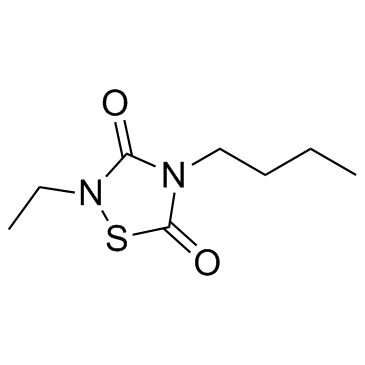CCG 203769
Modify Date: 2025-08-24 21:27:16

CCG 203769 structure
|
Common Name | CCG 203769 | ||
|---|---|---|---|---|
| CAS Number | 410074-60-1 | Molecular Weight | 202.274 | |
| Density | 1.2±0.1 g/cm3 | Boiling Point | 264.3±23.0 °C at 760 mmHg | |
| Molecular Formula | C8H14N2O2S | Melting Point | N/A | |
| MSDS | N/A | Flash Point | 113.6±22.6 °C | |
Use of CCG 203769CCG-203769 is a selective G protein signaling (RGS4) inhibitor, which blocks the RGS4-Gαo protein-protein interaction in vitro with an IC50 of 17 nM. |
| Name | CCG 203769 |
|---|---|
| Synonym | More Synonyms |
| Description | CCG-203769 is a selective G protein signaling (RGS4) inhibitor, which blocks the RGS4-Gαo protein-protein interaction in vitro with an IC50 of 17 nM. |
|---|---|
| Related Catalog | |
| Target |
RGS4:17 nM (IC50) RGS19:140 nM (IC50) RGS16:6 μM (IC50) RGS8:79 μM (IC50) GSK3β:5.4 μM (IC50) |
| In Vitro | CCG-203769 also displays dramatic selectivity (8- to >5000-fold) for RGS4 over other RGS proteins. CCG-203769 inhibits RGS19 with an IC50 of 140 nM (8-fold selective for RGS4) and 6 μM for RGS16 (350-fold selective for RGS4). The closely related RGS8 is very weakly inhibited (IC50>60 μM) providing >4500-fold selectivity for RGS4. CCG-203769 inhibits GSK-3β with an IC50 value of 5 μM. CCG-203769 does not inhibit the cysteine protease papain at 100 μM. CCG-203769 does not inhibit RGS7, which lacks cysteines in the RGS domain. CCG-203769 inhibits RGS/Gαo binding in an RGS-selective manner. CCG-203769 enhances Gαq-dependent cellular Ca2+ signaling in an RGS4-dependent manner. CCG-203769 also blocks the GTPase accelerating protein (GAP) activity of RGS4. In single-turnover and steady-state GTPase experiments with Gαo and Gαi1, the rate of GTP hydrolysis is strongly stimulated by RGS4, and this effect is inhibited by CCG-203769 with an IC50<1 μM. CCG-203769 has modest activity to inhibit ligand binding in membrane preparations for a small subset of the tested systems (α2 adrenergic, D3 dopamine, and opioid receptors)[1]. |
| In Vivo | To determine whether this genetic disruption of RGS4 function can be replicated pharmacologically, CCG-203769 is tested for effects on Carbachol-mediated bradycardia in conscious, unrestrained rats. Carbachol (0.1 mg/kg, IP) produces a modest decrease in heart rate compared to that of a saline vehicle control. CCG-203769 (10 mg/kg, IV) has no significant effect upon heart rate when given alone. However, CCG-203769, administered immediately prior to Carbachol, significantly potentiates the bradycardic effect (p < 0.05). Given the functional role of RGS4 in Parkinson’s disease models, CCG-203769 is tested in a pharmacologic model of D2 antagonist-induced bradykinesia. Raclopride administration in rats causes increased hang time in the bar test, which is rapidly reversed by doses of CCG-203769 ranging from 0.1 to 10 mg/kg. The lowest dose, 0.01 mg/kg has no effect, while 0.1 mg/kg produces a submaximal effect. The higher doses, 1 and 10 mg/kg, produce equivalent effects. Similarly, the raclopride-induced paw drag in mice is reversed by 0.1-10 mg/kg CCG-203769[1]. |
| Kinase Assay | Steady-state hydrolysis of unlabeled GTP is measured using malachite green in a receptor-independent assay utilizing a mutant Gαi1 (R178M, A326S). These mutations facilitate the release of GDP from the enzyme making the GTP hydrolysis step rate-limiting. GTP hydrolysis is measured by mixing 6 μM mutant Gαi with 300 μM GTP in 100 μL in 96-well plates in the presence or absence of 200 nM RGS4 and CCG-203769 or DMSO (vehicle control). All assay components are diluted in a buffer comprising 50 mM HEPES at pH 7.4, 100 mM NaCl, 0.01% Lubrol, 5 mM MgCl, and 10 μg/mL BSA. The reaction is allowed to proceed for 2 h at room temperature and then is quenched with 60 μL of an HCl/malachite green dye solution. Immediately after the addition of malachite green, 10 μL of 32% w/v sodium citrate is added as a colorimetric stabilizer, followed by incubation at room temperature for 20 min. Released inorganic phosphate is measured as an increase in absorbance (A630) from the complex of phosphate with malachite green. Background control samples lacking Gα are used to determine the rate of nonenzymatic GTP hydrolysis which is subtracted[1]. |
| Animal Admin | Mice[1] Young male (20-25 g; 8-9 weeks) C57BL/6J mice are used. Akinesia and bradykinesia are assessed 30 min after Raclopride, mice receive either DMSO or CCG-203769 (0.1-10 mg/kg, i.p.). Behavior is assessed 20 or 90 min after DMSO or CCG-203769. Rats[1] Adult Sprauge-Dawley rats receive CCG-203769 (10 mg/kg, i.v.) or saline (by i.v. infusion through the indwelling venous catheter over 30 s) while freely moving in their homecage. One minute later, saline or 0.1 mg/kg Carbachol (i.p.) is administered. Before and after i.v. infusions, catheters are flushed with approximately 0.5 mL of heparinized saline (50 U/mL) to check catheter patency and flush treatments from the dead space in the catheter. Following all experiments, rats are euthanized by i.v. Pentobarbital (150 mg/kg) to ensure catheter patency. Statistical significance is evaluated. |
| References |
| Density | 1.2±0.1 g/cm3 |
|---|---|
| Boiling Point | 264.3±23.0 °C at 760 mmHg |
| Molecular Formula | C8H14N2O2S |
| Molecular Weight | 202.274 |
| Flash Point | 113.6±22.6 °C |
| Exact Mass | 202.077591 |
| LogP | 0.65 |
| Vapour Pressure | 0.0±0.5 mmHg at 25°C |
| Index of Refraction | 1.527 |
| InChIKey | WTFFYZGCISALRI-UHFFFAOYSA-N |
| SMILES | CCCCn1c(=O)sn(CC)c1=O |
| Storage condition | 2-8℃ |
| 4-Butyl-2-ethyl-1,2,4-thiadiazolidine-3,5-dione |
| RGS4 inhibitor 11b |
| 1,2,4-Thiadiazolidine-3,5-dione, 4-butyl-2-ethyl- |